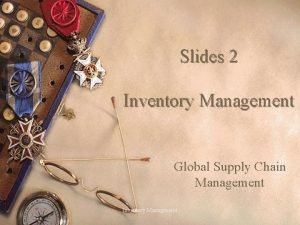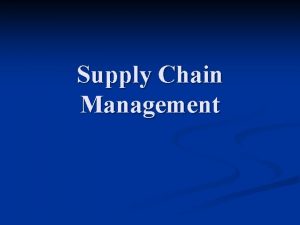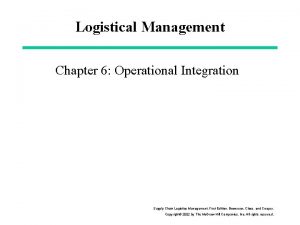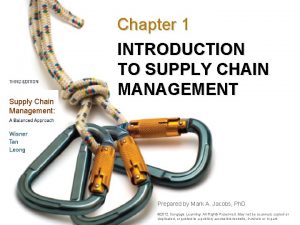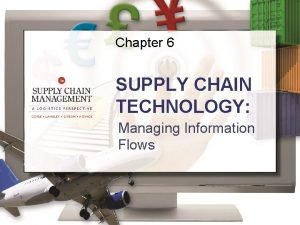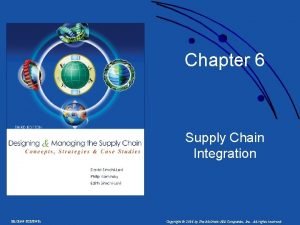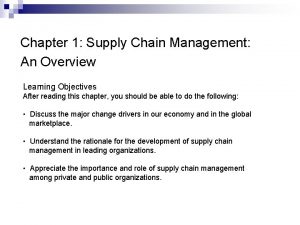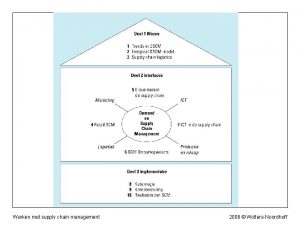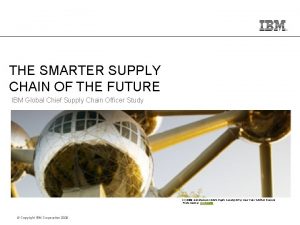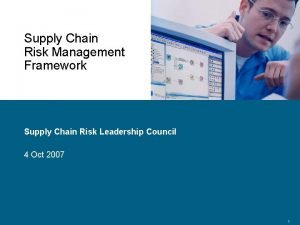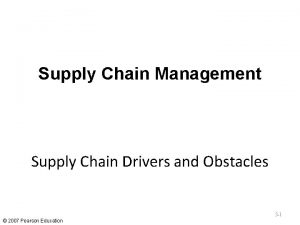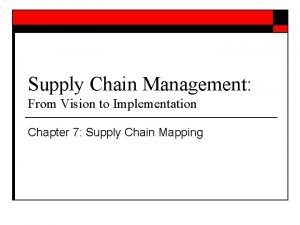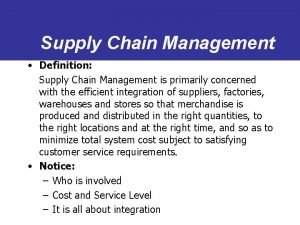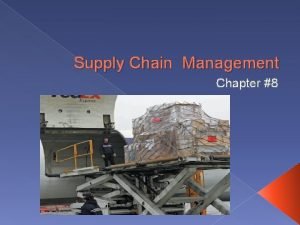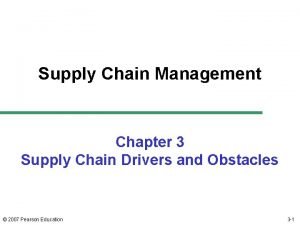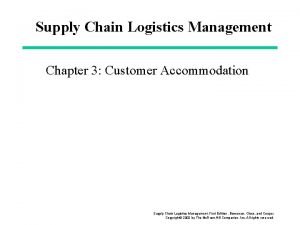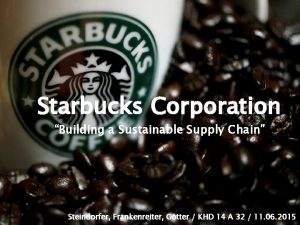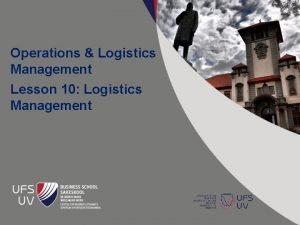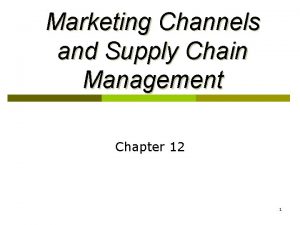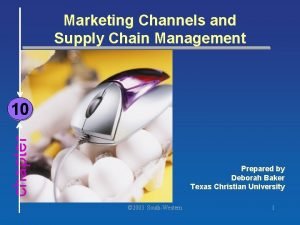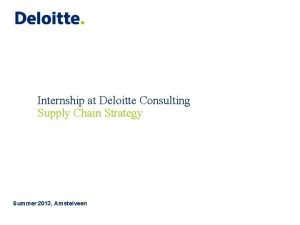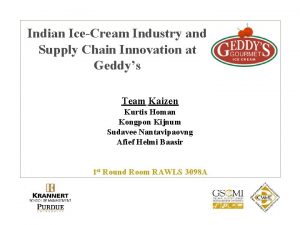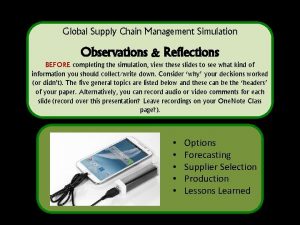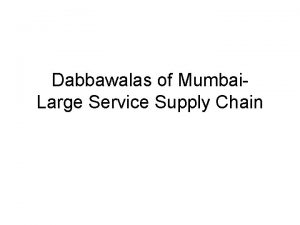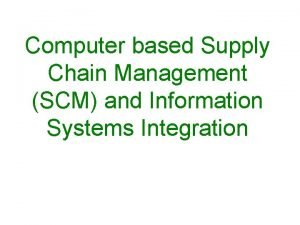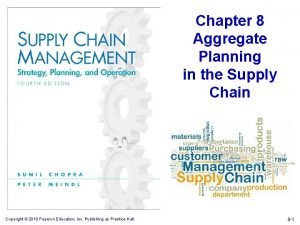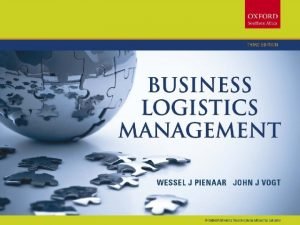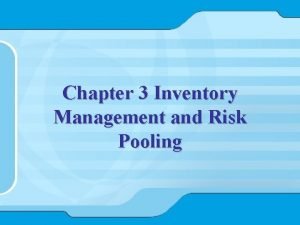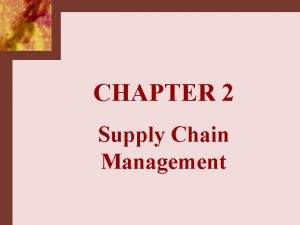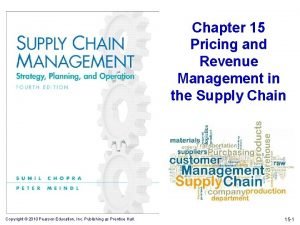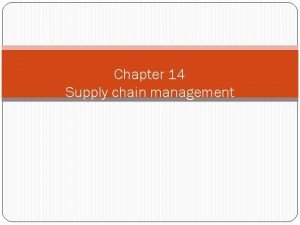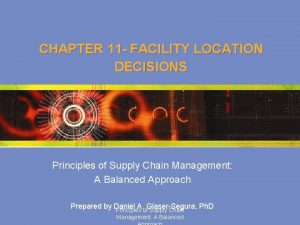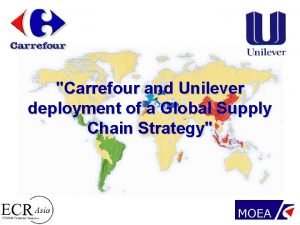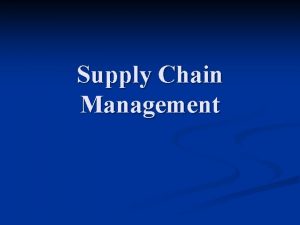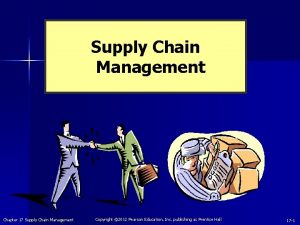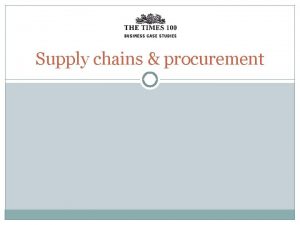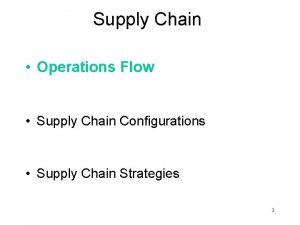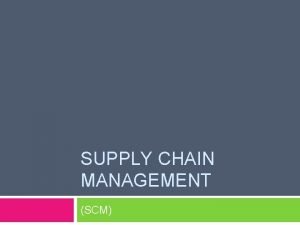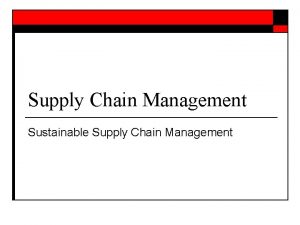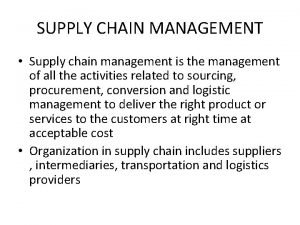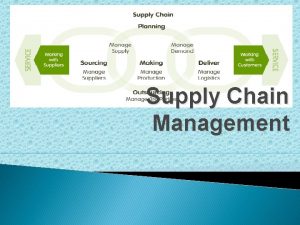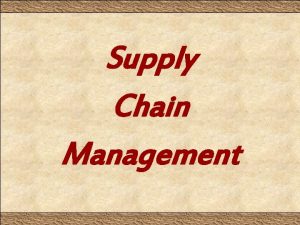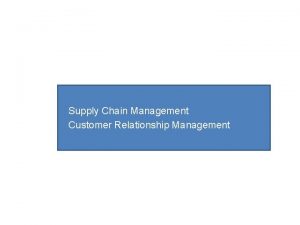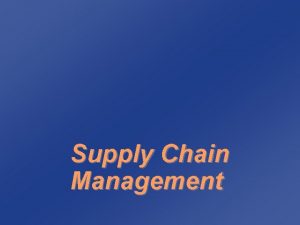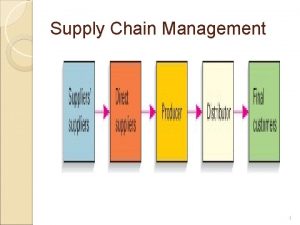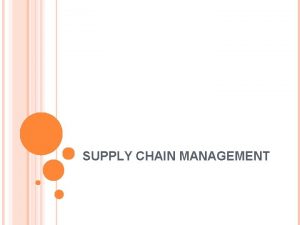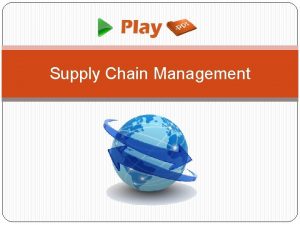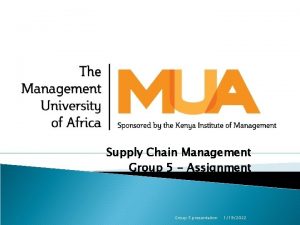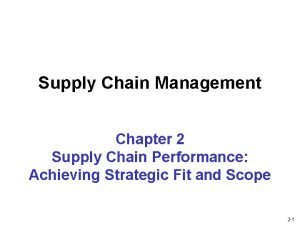Slide 6 1 CHAPTER 6 SUPPLY CHAIN MANAGEMENT












































- Slides: 44

Slide 6. 1 CHAPTER 6 SUPPLY CHAIN MANAGEMENT

Slide 6. 2 Learning outcomes Identify the main elements of supply chain management and their relationship to the value chain and value networks Assess the potential of information systems to support supply chain management and the value chain.

Slide 6. 3 Management issues Which technologies should we deploy for supply chain management and how should they be prioritized? Which elements of the supply chain should be managed within and beyond the organization and how can technology be used to facilitate this?

Slide 6. 4 SCM – some definitions Supply chain management (SCM) The coordination of all supply activities of an organization from its suppliers and partners to its customers Upstream supply chain Transactions between an organization and its suppliers and intermediaries, equivalent to buy-side e-commerce Downstream supply chain Transactions between an organization and its customers and intermediaries, equivalent to sell-side e-commerce.

Members of the supply chain: (a) simplified view, (b) including intermediaries Figure 6. 1

Slide 6. 6 The main strategic thrust of enhancing supply chain is to provide a superior value proposition to the customer. Efficient customer response is one method for the same. Improving customer value = improving product quality, customer service quality and/or reducing price and fulfillment times.

Slide 6. 7 Efficient Customer Response Was developed by food retailing business in USA Since then, has been applied to other products and in other countries.

Table 6. 1 Objectives and strategies for effective consumer response (ECR)

Slide 6. 9 Using technology to support SCM Early implementation: 1989 -1993 PC-based Electronic trading gateway: 1990 -1994 EDI-based EDI purchasing system but involved a wider range of parties The move towards Internet commerce: 1996 onwards Provide a lower-cost alternative to traditional EDI

Slide 6. 10 Case Study BHP Steel – An Australian Firm Its use of PC-based SCM dates back to the 1980 s E-business here represents a change of emphasis rather than a radically new approach

Slide 6. 11 A history of SCM at BHP Steel Early implementation 1989 -1993. This was a PC-based EDI purchasing system. Objectives: Benefits included: reduce data errors to 0, reduce administration costs, improve management control, reduce order lead time. rationalization of suppliers to 12 major partnerships (accounting for 60% of invoices). 80% of invoices placed electronically by 1990. 7000 items were eliminated from the warehouse, to be sourced directly from suppliers, on demand. Shorter lead times in the day to day process– from 10 days to 26 hours for items supplied through a standard contract and from 42 days to 10 days for directpurchase items. Barriers: Mainly technological.

Slide 6. 12 Electronic trading gateway 19901994 Character Aim Also EDI-based, but involved a wider range of parties both externally (from suppliers through to customers) and internally (from marketing, sales, finance, purchasing and legal) Provide a combined upstream and downstream supply chain solution to bring benefits to all parties Learnings The difficulty of getting customers involved – only four were involved after 4 years, although an industry-standard method for data exchange was used. This was surprising since suppliers had been enthusiastic adopters. From 1994, there was no further uptake of this system.

Slide 6. 13 The move towards Internet commerce 1996 onwards The Internet was thought to provide a lower-cost alternative to traditional EDI for smaller suppliers and customers, through using a lower-cost value-added network. Objectives: Strategy divided transactions into 3 types: Strategic (high volume, high value, high risk) – a dedicated EDI line was considered most appropriate. Tactical (medium volume, value and risk) EDI or Internet EDI was used. Consumer transactions (low volume, value and risk) – a range of lower-cost Internet-based technologies could be used. Benefits: Extend the reach of electronic communications with supply chain partners. Broaden the type of communications to include catalogue ordering, freight forwarding and customer ordering. One example of the benefits has been reducing test certificates for products from $3 to 30 cents. Barriers: The main barriers to implementation at this stage have been business issues, i. e. convincing third parties of the benefits of integration and managing the integration process.

Slide 6. 14 A simple model of supply chain An organization’s supply chain can be viewed from a system perspective as the : Acquisition of resources (inputs) Transformation into products and service (process) Products and services (outputs) { s}

Slide 6. 15 Supply chain management can dramatically have an impact on the profitability of a company through reducing operating costs and increasing customer satisfaction and so loyalty and revenue.

Figure 6. 2 A typical supply chain (an example from The B 2 B Company)

Slide 6. 17 What is logistics? Logistics is the time related positioning of resource, or the strategic management of the total supply chain.

Slide 6. 18 What is logistics? Used to refer specifically to the management of logistics or inbound and outbound logistics Inbound logistics: The management of material resources entering an organization from its suppliers and other partners Outbound logistics: The management of material resources supplied from an organization to its customers and intermediaries

Push and pull supply chain models Figure 6. 3 Push and pull approaches to supply chain management

Slide 6. 20 The Value Chain A model that considers how supply chain activities can add value to products and services to be delivered to the customer Benefits for customers are created by reducing costs and adding value to customers within each element of the value chain and at the interface between elements of the value chain

Slide 6. 21 In equation form, Value = (benefit of each VC activity – its cost) + (benefit of each interface between VC activities – its cost)

Slide 6. 22 - - Electronic communication can be used to enhance the value chain by: making value chain activities (eg. Procurement) more efficient enabling data integration between activities

Slide 6. 23 Internet enables value to be created by gathering, organizing, selecting, synthesizing and distributing information. Virtual value chain – processing is machine based rather than paper based.

Two alternative models of the value chain: (a) traditional value chain model, (b) revised value chain model Figure 6. 4 Source: Figure 6. 4(b) adapted from Deise et al. (2000)

Slide 6. 25 Internet technologies can reduce production time and costs by increasing the flow of information as a way to integrate different value chain activities. Through this the value chain can be made more efficient and services delivered to customers more readily.

Slide 6. 26 Restructuring the internal value chain Some weaknesses in the traditional value chain: Most applicable to manufacturing of physical products It is a one-way chain involved with pushing products to the customer Does not highlight the importance of understanding customer needs Does not emphasise the importance of value networks

Slide 6. 27 Towards virtual organization An organization which uses information and communication technology to allow it to operate without clearly defined physical boundaries between different functions. Characteristics: Lack of physical structure Reliance on knowledge Use of communications technology Mobile work Boundaryless and inclusive Flexible and responsive

The Worldwide Universities Network showing member institutions (www. wun. ac. uk) Figure 6. 6

Slide 6. 29 Restructuring the Supply Chain as part of strategy definition for e-business SCM options can be seen as a continuum between internal control of supply chain elements and external control of supply chain elements through outsourcing. The two end elements of the continuum are referred to as Vertical Integration and Virtual Integration. The intermediate situation is referred to as Vertical Disintegration or Supply Chain Disaggregation.

Slide 6. 30 Vertical Integration The extent to which supply chain activities are undertaken and controlled within the organization.

Slide 6. 31 Virtual Integration The majority of supply chain activities are undertaken and controlled outside the organization by third parties.

Options for restructuring the supply chain The characteristics of vertical integration, vertical disintegration and virtual integration Figure 6. 7

Popularity of different e-business applications in Europe according to company size Figure 6. 8 Source: e. Europe (2005)

Figure 6. 10 Barriers to implementing information and communications technology Source: DTI (2004), Fig. 5. 2 f

Slide 6. 35 Benefits of applying IS to SCM Increased efficiency of individual processes Reduced complexity of the supply chain -disintermediation Benefit: reduced cost of paper processing Reduced cost through outsourcing Benefit: reduced cost of channel distribution and sale Improved data integration between elements of the supply chain Benefit: reduced cycle time and cost per order Benefits: lower costs through price competition and reduced spend on manufacturing capacity and holding capacity. Better service quality through contractual arrangements? Innovation Benefit: better customer responsiveness.

Slide 6. 36 Benefits to buying company/customers Increased convenience through 24 hours a day, 7 days a week, 365 days ordering Increased choice of supplier leading to lower costs Faster lead times and lower costs through reduced inventory holding The facility to tailor products more readily Increased information about products and transactions such as technical data sheets and order histories

Slide 6. 37 IS-supported upstream SCM The key activities of upstream SCM are procurement and upstream logistics RFID (radio-frequency identification microchip) Microchip-based electronic tags are used for monitoring anything they are attached to

Slide 6. 38 IS-supported downstream SCM Involves selling direct to customers Operating a strategy of disintermediation by reducing the role of its branches

Slide 6. 39 Outbound logistic management Relates to the expectations of offering sales through a web site

Slide 6. 40 IS Infrastructure for SCM Its required to deliver supply chain visibility to different parties. Hence there is a need for an integrated supply chain database with different personalized views for different parties

Slide 6. 41 A Typical IS Infrastructure Applications can be divided into those for planning and those for executing, the supply chain process. Key feature is the use of a central operational database that enables information to be shared between supply chain processes and applications. This database is usually part of an ERP system. Use of internet technologies to deliver information over a TCP/IP protocol

Figure 6. 11 A typical IS infrastructure for supply chain management

Figure 6. 12 Alternative strategies for modification of the e-business supply chain

 Supply chain management slide
Supply chain management slide Heel and toe polka dance
Heel and toe polka dance Functional components of e-crm
Functional components of e-crm Contemporary management practices
Contemporary management practices Sequence of typical manufacturing supply chain
Sequence of typical manufacturing supply chain Matching supply and demand in supply chain
Matching supply and demand in supply chain Chapter 6 supply chain management
Chapter 6 supply chain management Chapter 1 supply chain management
Chapter 1 supply chain management Chapter 6 supply chain management
Chapter 6 supply chain management Chapter 6 supply chain management
Chapter 6 supply chain management Chapter 1 supply chain management
Chapter 1 supply chain management Value chain and supply chain difference
Value chain and supply chain difference Food chain food chain food chain
Food chain food chain food chain Werken met supply chain management noordhoff
Werken met supply chain management noordhoff Ibm global supply chain management
Ibm global supply chain management Supply chain risk management framework
Supply chain risk management framework Supply chain risk management framework
Supply chain risk management framework Supply chain cisco
Supply chain cisco Drivers of supply chain management
Drivers of supply chain management Supply chain management process mapping
Supply chain management process mapping Intraoperation scope
Intraoperation scope Order promising module of supply chain management
Order promising module of supply chain management Chapter 3 supply chain drivers and metrics
Chapter 3 supply chain drivers and metrics Customer accomodation
Customer accomodation Starbucks supply chain diagram
Starbucks supply chain diagram Logistics management introduction
Logistics management introduction The network made up of the company suppliers distributors
The network made up of the company suppliers distributors Marketing channels and supply chain management
Marketing channels and supply chain management Principes fondamentaux supply chain management pdf
Principes fondamentaux supply chain management pdf Deloitte supply chain internship
Deloitte supply chain internship Supply chain management in ice cream industry
Supply chain management in ice cream industry Global supply chain management simulation
Global supply chain management simulation Ford mmog
Ford mmog Dabbawala supply chain management
Dabbawala supply chain management Computer based supply chain management
Computer based supply chain management Aggregate planning in supply chain examples
Aggregate planning in supply chain examples Supply chain vision statement
Supply chain vision statement Risk pooling supply chain management meaning
Risk pooling supply chain management meaning Cscmp logistics definition
Cscmp logistics definition Role of pricing and revenue management in a supply chain
Role of pricing and revenue management in a supply chain Scheduling in supply chain management
Scheduling in supply chain management Facility location decisions in supply chain management
Facility location decisions in supply chain management Carrefour supply chain strategy
Carrefour supply chain strategy Basics of supply chain management
Basics of supply chain management Supply chain drivers and metrics
Supply chain drivers and metrics
